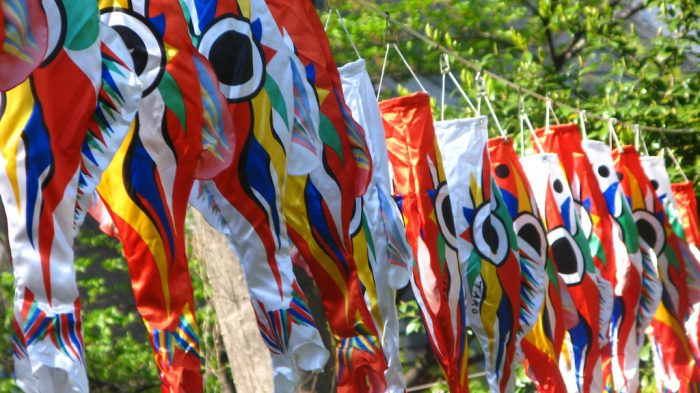
Tokyo in May is when the school kids and salarymen get to unwind, which starts with Golden Week. Golden Week is a much needed vacation for the hard working people of Tokyo and it essentially begins on April 29th, The Emperor’s Birthday. Constitution Memorial Day on May 3rd and Children’s Day on May 5th continue the holiday extravaganza. The izakaya (Japanese-style pub) in Tokyo are more lively throughout Golden Week and the overall vibe among locals is joyful. Eating and drinking in excess are rampant all month, as friends and families hang out. Drinking on the streets of Tokyo is pretty normal, but in May it becomes commonplace. The festivals at various shrines and temples around Tokyo are awesome. Excellent street food like tako-yaki, aka octopus balls (not testicles) are a crowd pleaser, as is chocolate dipped bananas and tai-yaki (fish shaped batter filled with sweet beans). There are a plenty of games to play, mostly for the kids, but it’s fun for everyone just to soak in the experience and watch the happiness.
Children’s Day (Kodomo no Hi こどもの日)
Children’s Day (May 5th) is a holiday that honors the happiness of children and celebrates their mothers. Carp (fish) flags blow in the wind all over Tokyo on Children’s Day, something the Japanese adapted from a Chinese legend about a carp that swims upstream and becomes a dragon. Mochi rice cakes wrapped in kashiwa (oak) leaves called kashiwa-mochi (mochi filled with red bean jam) and chimaki (a type of “sweet rice paste”, wrapped in an iris or bamboo leaf) are the go-to eats on this day; kids and adults alike love these traditional treats.
Kanda Matsuri Festival
Kanda-Matsuri Festival is a huge festival, in fact it’s one of Japan’s largest. For 6 days crowds are celebrating the deities of the Kanda Shrine with parades, floats, and munks on horses. The Shinko-sai parade features mikoshi portable shrines and they move from Kanda all the way to Akihabara. Mikoshi Miya-iri is a parade with a hundred floats that eventually enter the shrine for worship. These two parades are excellent examples of the Japanese energy during festivals and celebrations. This year it starts May 7th and ends on May 15th.
Asakusa Sanja Matsuri Festival
The Sanja Matsuri is full of portable shrines and traditional music. Massive shrines carried by enthusiastic men make for great atmosphere as drums are beat loudly behind them. There are even shrines carried by kids, as proud parents look on. Usually the festival begins in the morning, but the parade starts around 1:00pm right by Asakusa Station. You will get to see a fair amount of Japanese man butt, for whatever that’s worth.
Tags: Golden Week
Categorised in: Asakusa, Customs and Culture, Festivals, Tokyo, Travel In Japan
This post was written by Mathew Ryan
Tokyo in May is when the school kids and salarymen get to unwind, which starts with Golden Week. Golden Week is a much needed vacation for the hard working people of Tokyo and it essentially begins on April 29th, The Emperor’s Birthday. Constitution Memorial Day on May 3rd and Children’s Day on May 5th continue the holiday extravaganza. The izakaya (Japanese-style pub) in Tokyo are more lively throughout Golden Week and the overall vibe among locals is joyful. Eating and drinking in excess are rampant all month, as friends and families hang out. Drinking on the streets of Tokyo is pretty normal, but in May it becomes commonplace. The festivals at various shrines and temples around Tokyo are awesome. Excellent street food like tako-yaki, aka octopus balls (not testicles) are a crowd pleaser, as is chocolate dipped bananas and tai-yaki (fish shaped batter filled with sweet beans). There are a plenty of games to play, mostly for the kids, but it’s fun for everyone just to soak in the experience and watch the happiness.
Children’s Day (Kodomo no Hi こどもの日)
Children’s Day (May 5th) is a holiday that honors the happiness of children and celebrates their mothers. Carp (fish) flags blow in the wind all over Tokyo on Children’s Day, something the Japanese adapted from a Chinese legend about a carp that swims upstream and becomes a dragon. Mochi rice cakes wrapped in kashiwa (oak) leaves called kashiwa-mochi (mochi filled with red bean jam) and chimaki (a type of “sweet rice paste”, wrapped in an iris or bamboo leaf) are the go-to eats on this day; kids and adults alike love these traditional treats.
Kanda Matsuri Festival
Kanda-Matsuri Festival is a huge festival, in fact it’s one of Japan’s largest. For 6 days crowds are celebrating the deities of the Kanda Shrine with parades, floats, and munks on horses. The Shinko-sai parade features mikoshi portable shrines and they move from Kanda all the way to Akihabara. Mikoshi Miya-iri is a parade with a hundred floats that eventually enter the shrine for worship. These two parades are excellent examples of the Japanese energy during festivals and celebrations. This year it starts May 7th and ends on May 15th.
Asakusa Sanja Matsuri Festival
The Sanja Matsuri is full of portable shrines and traditional music. Massive shrines carried by enthusiastic men make for great atmosphere as drums are beat loudly behind them. There are even shrines carried by kids, as proud parents look on. Usually the festival begins in the morning, but the parade starts around 1:00pm right by Asakusa Station. You will get to see a fair amount of Japanese man butt, for whatever that’s worth.
Tags: Golden Week
Categorised in: Asakusa, Customs and Culture, Festivals, Tokyo, Travel In Japan
This post was written by Mathew Ryan